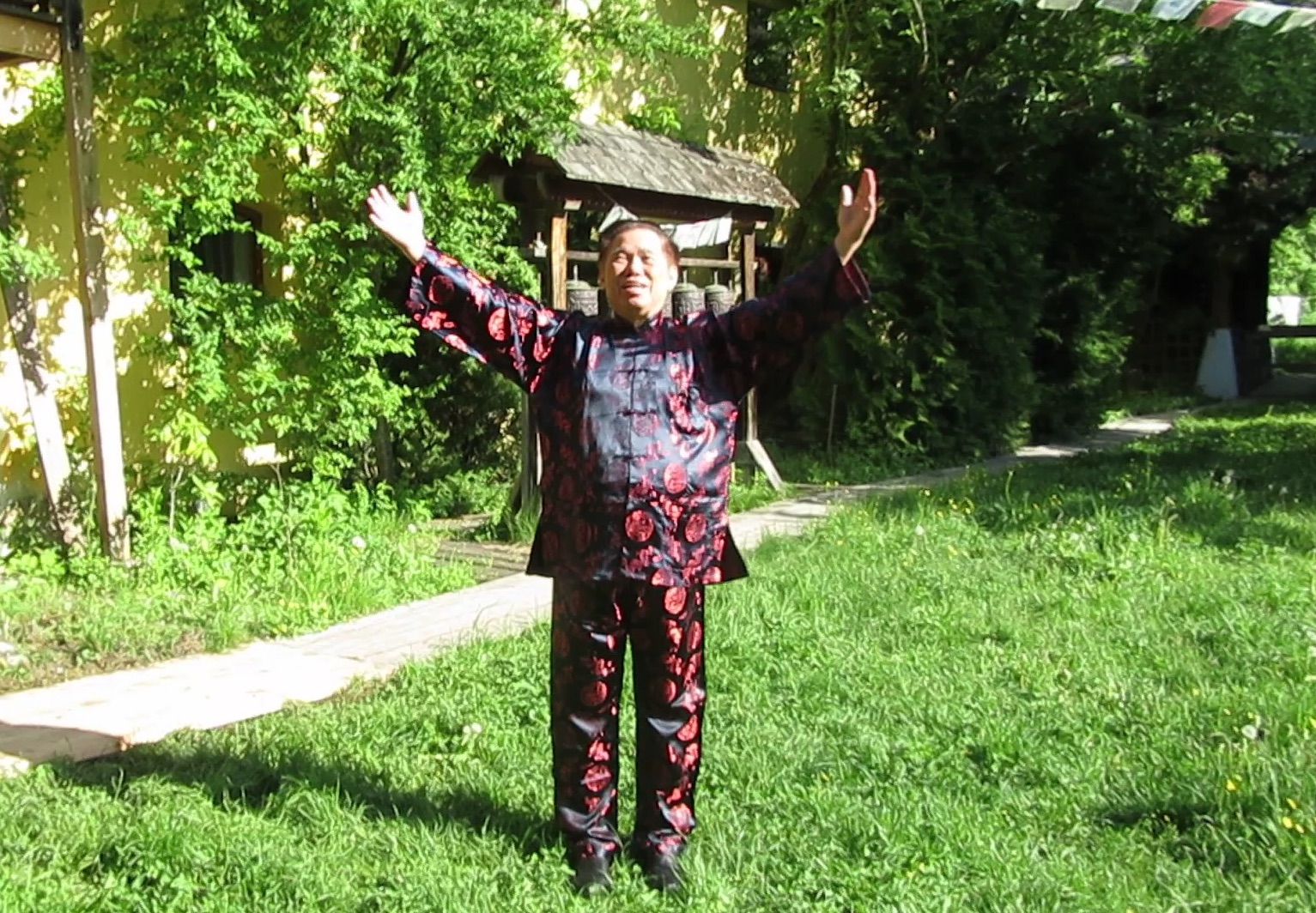TWO ASPECTS OF YIN-YANG, LIFTING THE SKY AND DANCING BUTTERFLY

"Two Aspects of Yin-Yang" from the Abridged San Feng Set
Question
As part of the "Abridged San Feng" set we practice "Two aspects of Yin-Yang". What are the therapeutic benefits and therapeutic differences of this exercise compared to "Lifting The Sky" and "Beautiful Butterfly Dances in Front of Flowers"?
Sifu Tim Franklin, Shaolin Wahnam UK
Answer
"Two Aspects of Yin-Yang" is the starting pattern of the Abridged San Feng Wudang Set. It is also the starting pattern of the San Feng Wudang Set as well as the Wudang Taijiquan Set, though in the picture series of Wudang Taijiquan Set the first picture is "Cosmos One Unity", which is standing at the Wuji Stance.
It is worthy of note that the Wudang Taijiquan Set was reconstructed by me based on the patterns mentioned in a Wudang Kungfu classic, and on Zhang San Feng’s Treatise of Taijiquan recorded in “Focusing Spirit Accumulating Energy in the Grand Ultimate Practice”, as well as all resources I could get on Wudang Taijiquan.
It was also based on my understanding and experience. For example, from my understanding and experience Taijiquan should be performed in gentle, flowing manner without beginning and without ending. I would not composed a set where the patterns were performed in a staccato manner.
Anyone with some understanding of the philosophy of the Abridged San Feng Wudang Set, as well as the San Feng Wudang Set and Wudang Taijiquan Set, would wonder why this pattern, “Two Aspects of Yin-Yang”, is the start of the set. Those who have no understanding of its philosophy would perform the set in the way it has been composed.
All kungfu sets begin with the Shaolin “Focusing Chi at the Dan Tian”, or the Taijiquan “Two Aspects of Yin-Yang” as it is called in the Wudang Taijiquan Set, or “Bringing Chi from the Cosmos” as we sometimes call this pattern. The great majority of those who perform any kungfu sets do not know the significance behind these patterns. I remember Emiko telling me that in wushu performance, the significance was that the performer looked nice.
“Focusing Chi at the Dan Tian” is performed by bringing both palms up at the sides of the body, then in front of the body turning the palms to face downward and lowering them to the dan tian before bringing the fists at both sides of the waist. The purpose is to let the chi flowing and then focus it at the dan tian, which is very useful for performing any kungfu set. Any movement of the set needs flowing chi and the dan tian acts like a reservoir of chi.
“Two Aspects of Yin-Yang” is performed by bringing both palms, initially facing upward, from the sides of the body up to above the head, then bringing the palms, now facing downward, to the dan tian. The palms are now brought in two fists to the sides of the wrist, or left hanging straight but loosely at the sides of the body.
The function of “Two Aspects of Yin-Yang” is quite similar to “Focusing Chi at the Dan Tian”, with the exception that in the former chi is gathered from the Cosmos, whereas in the latter chi is made to flow in the performer’s body.
Which pattern is superior? It depends on the purpose of performing the set. From experience I have discovered that relatively “Focusing Chi at the Dan Tian” is more powerful, whereas “Two Aspects of Yin-Yang” is more flowing.
Why is the pattern called “Two Aspects of Yin-Yang”? It is because innately there are two aspects to the same reality where they are both opposite and complimentary to each other. One of the aspect is symbolized as “yin” and the other aspect is symbolized as “yang”.
In Wuji, or the Great Void, energy is undifferentiated, and innately one aspect which is quiescent is symbolized as “yin”, and the other aspect which is dynamic is symbolized as “yang”. In “Taiji”, or the Cosmos with myriad differentiated things, the quiescent is symbolized as “yin” and the dynamic is symbolized as “yang”.
Not all things are strictly perfectly quiescent or dynamic. Some are more quiescent than dynamic, and vice versa. But all things are symbolized as “yin” and “yang”.
The similarity in “Two Aspects of Yin-Yang”, “Lifting the Sky” and “Beautiful Butterfly Dances in Front of Flowers” is that all the three patterns move energy. Moving energy to let the energy flow has great therapeutic benefit. If the energy stagnates, it causes illness.
“Two Aspects of Yin-Yang” moves energy generally. “Lifting the Sky” and “Beautiful Butterfly Dances in Front of Flowers” move energy in specific ways. “Lifting the Sky” moves energy in a practitioner’s body, excellent in generating an overall energy flow. “Beautiful Butterfly Dances in Front of Flowers” moves energy in the chest, excellent in overcoming depression.
We shall perform “Two Aspects of Yin-Yang” at the coming UK Summer Camp 2018, and at the “Cultivating Spirit Nourishing Energy” course in Penang. We shall also perform “Lifting the Sky” and “Beautiful Butterfly Dances in Front of Flowers” as a comparison. If I forget to mention these two latter patterns, some kind soul please reminds me.

Lifting the Sky
The questions and answers are reproduced from the thread Questions to Grandmaster on Wudang Kungfu/Taijiquan & Zhang San Feng in the Shaolin Wahnam Discussion Forum.
LINKS
